 Facebook
Facebook
 X
X
 Instagram
Instagram
 TikTok
TikTok
 Youtube
Youtube
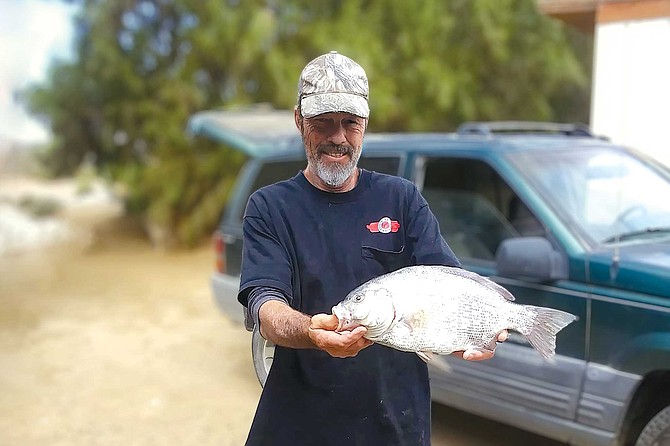
Moving to the San Quintin area in 2015 was more accident than planned, but it wasn’t entirely random. Whenever I’ve pulled up stakes and moved on, for whatever reason — work, family, relationship, or a dart thrown at a map — I have been quick to find the fishing in my new environs. This time, I was basing my decision on distance: I needed someplace from which I could make the round trip to San Diego in a day. Say, four to five hours drive-time. That way, if I timed my border crossings well to avoid sitting in traffic, I could make it from home to Downtown San Diego — there to pick up the bi-weekly check that paid for my life in Mexico — and still sleep in my own bed that night. I aimed for someplace between Ensenada and El Rosario, drawn, as ever, by the water and what was swimming around under its surface.
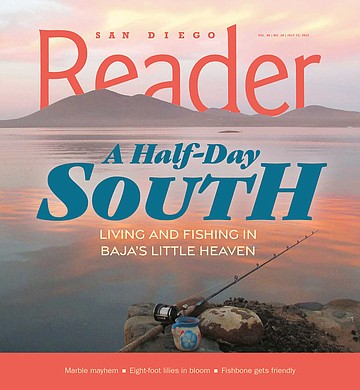
The easiest way to search for a place to live is to go online. But when is the easiest way ever really the best? I knew I would find better deals speaking the with locals. My normal M.O. when I’m planning on an extended stay in Baja to find an area, make a deal for a week or maybe a month at a cheap motel, and then start looking through local channels; people you meet while out and about, notes posted outside of tiendas, that sort of thing. So I started driving south. A two-bedroom house for $600 in La Misión was tempting, but overbudget. A trailer by the Rosarito Beach Pier was within budget, but I wanted to be south of Ensenada and in a more rural setting. There were possibilities in Camalu, Colinet, and in the San Quintin Valley, but I found that the further south I drove, the further south I wanted to be. I decided to push my one-day round-trip requirement to its limit.
I was thinking El Rosario, but thanks to all my stops along the way, the sun was setting, and I typically avoid night driving in Baja. Besides, the cat started yowling — Mollison McReedy, the stray I found when she was more mouse-sized than cat-sized, and starving in the rocks on the Mission Beach jetty. She’d lived in Mexico before, back in 2005-2008 when she was a younger, better murderer of scorpions and mice, and I was plunked down outside of La Paz. Tired from the road, I pulled off the highway at the Los Piños Pemex station and headed four miles toward the beach and the Cielito Lindo Hotel.
A little Hollywood in the history
There’s a story that Mark Armistead, after he invented the instant replay for television, took his million-dollar check from NBC and tried to cash it at the bar of his favorite restaurant, Newport Beach’s El Pescador Restaurant and Bar. He was kidding, but the money was serious, serious enough that in the late ‘60s, Armistead was able to buy Rancho El Manana, 400 acres of sandy flat scrub land between the sloughs of Bahia San Quintin and the dunes fronting Playa Santa Maria, about 180 miles south of San Diego. Maybe his buddy the director John Ford had spotted it while spying on Japanese vessels in coastal Mexican waters in the late 1930s before the outbreak of World War Two, or during one of their many fishing trips down the coast after the war. However he found it, it seemed like the perfect spot to recreate El Pescador and invite the same Hollywood heavies with whom he’d dined there. Armistead named his recreation Cielito Lindo, Spanish for “pretty little sky.” Or it could be “nice little heaven.” The point is that the view is nice.
Large hotel rooms were added in three single-story fourplex units, floored with onyx tiles sourced from the once-famous and largest onyx-producing quarry in the world, El Mármol, located inland and about a third of the way down the Baja Peninsula. Armistead, a naval pilot and photographer during the war, installed an airstrip, and soon he and Ford — along with other Hollywood notables, including John Wayne, Henry Fonda, and Jimmy Stewart — started flying down to escape the paparazzi and fans in Los Angeles.
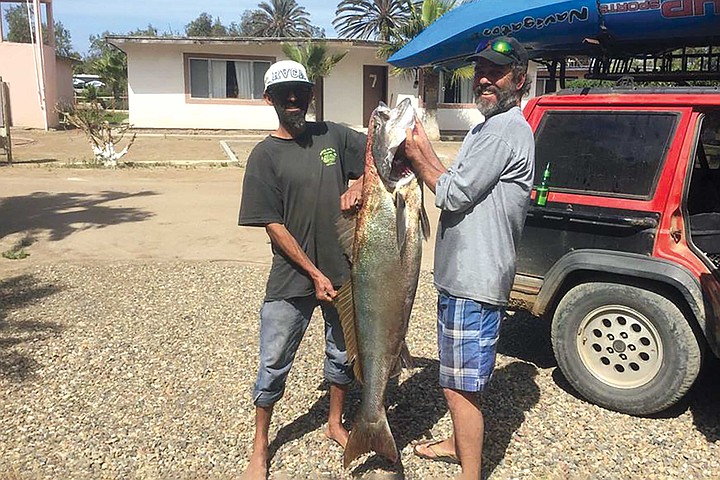
Mexico abounds with tales of famous visitors, from writers who loved fishing, like John Steinbeck and Ernest Hemingway, to actors who loved loving, like Elizabeth Taylor and Richard Burton. The Lover’s Bridge in Puerto Vallarta is so named because of their affair during the filming of Night of the Iguana, a tryst so public that it was condemned as “erotic vagrancy” by the Vatican. As it happened, Liz and Richard’s affair is pointed to as the beginning of the public “craze” of fandom — which is why Armistead and company desired a private getaway out of the public eye.
It seems they achieved their dream: there were no pictures or signed headshots behind the bar. What stories might have been told about the Hollywood crowd while at Cielito Lindo, if there were any, circulated far away from the eyes and ears of historians, the press, or any other public record. What is known is that when the highway was paved and RVs full of tourists began venturing south beyond Ensenada, Mark Armistead put the place up for sale, and it was bought by Juanita Fitzpatric in 1975.
Though she sold the restaurant, bar, and hotel to a ranching family from Mexicali prior to my moving here, Fitzpatric still holds title to the leased properties on the remaining acreage, where some 37 residents have built off-grid homes. A lot runs $100 down and $65 per month. Most of the homes are on solar and have generators as backup — as do the bar, restaurant, and hotel. Water is delivered to storage tanks, or pilas, by truck at a reasonable price. Every day, rain or shine, at 4 pm, happy hour draws the residents to the outdoor seating area, where locals, dogs, and guests all mingle.
El Pescador
Affordable rates a half-day from San Diego; it was time to assess my other nonnegotiable: a decent kayak launch. I found one at the bay mouth, or Boca, a few miles up the spit. The fact that the place was walking distance to the beach was just a bonus. Cielito Lindo soon became my home base, even though I hadn’t yet realized the potential of the area. Having previously lived in La Paz and Mulege, and having spent my vacations somewhere between Gonzaga Bay and the East Cape, I associated Baja with Tuscon-type warmth and near-tropical Sea of Cortez water. Exploring and fishing the Pacific side of the peninsula was going to be a new adventure in an almost foreboding place, what with its not-so-ancient volcanoes, shallow bay, and shallow sloping beaches. It almost seemed more like Central California: gray and cool, with a long paddle to the fishing grounds. The fishery held good rockfish, yellowtail, and white seabass — if you had the boat to do 25-40-mile round trips. But it seemed less than ideal for kayak-angling. I had gotten a little spoiled on the east side, where I could paddle out and chase dorado and tuna within a mile of the beach — and catch yellows just by chucking iron from shore.
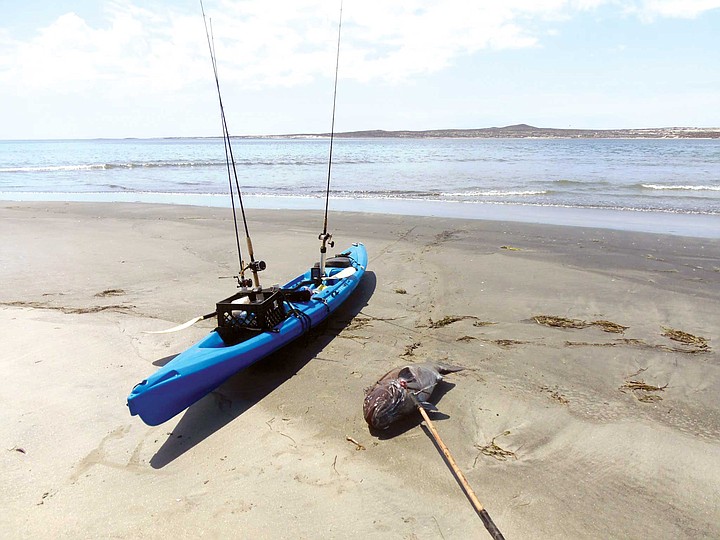
My first launches at the bay mouth resulted in lots of sand bass and a couple of small halibut, and my first sand crab-chucking beach trips produced some barred surf perch and corbina. But then I started to learn more about the history of the place and the fishery, much of it from Captain Juan Cook, who runs a sportfishing operation out of The Old Mill, a hotel on the upper bay on the site of a mill built to process grain grown by British wheat farmers in the early 1900s. I began taking trips on pangas — the small skiffs that are the working boats of Mexico.
Catches on the 15 and 240 banks, as well around Isla San Martin (see photo), were the expected seasonal targets: rockfish, lingcod, and yellowtail from the high spots, seasonal tuna and dorado offshore, and white seabass, halibut, and really good calico bass on and near the kelp around the island. Often, large sheephead and whitefish were in the mix, too.
The panga fishing was good, but I still made time to explore the bay from the low perch of my kayak, and I made sure to talk to local fishermen — commercial and recreational — about what it held. What I found was a huge nursery for all kinds of gamefish, choked with bait — from finfish and to unending ghost shrimp beds in massive natural littoral zones, or “false bays.” A local handyman who fished for extra money told me of the large green and white shrimp —the latter known as cameron de leche or “milk shrimp,” due to their naturally white tail meat — that inhabited the bay. He caught them by casting his net in the sloughs after a high tide had dropped and left pools he could access. He brought me a couple kilos of them; the would be sold as extra-large at U.S. markets.
Over the first few months of kayak fishing within the bay — from the Boca up to the Old Mill – my catches included bonefish, young black seabass, juvenile gulf and broomtail grouper, halibut, sole, sand bass, spotted bay bass, numerous rays, a large spawning white seabass, juvenile white seabass, and California corbina. I even found I did not have to paddle very far for yellowtail: I caught one in the shallows near the launch at the Boca, and several within the mile-and-a half-paddle from there to the point.
Over the years since first fishing in the San Quintin area in 2015, I have caught my personal best California corbina (5.7 pounds) and barred surf perch (3.17 pounds) from the beach; and from the kayak in the Boca, white seabass (55 pounds), and kept black seabass (75 pounds). Fun fact: a kayak can act as a bobber might for a perch; a large fish that would take all your line from a boat will often just wear itself out towing a kayak. The angler can button down the drag and not be broken off. Once I’ve gaffed the fish, I normally use a bat to knock it out. Then I can remove the hook and store it in my forward hatch, or leash and tow it if it’s too large.
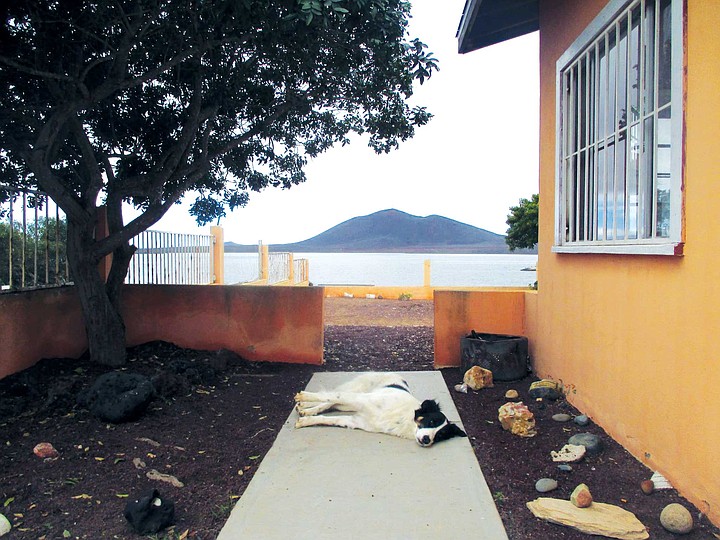
Bed and board
But all that came later. After first arriving, tired and accompanied by an aging, grouchy cat, I made a deal with the owner of Cielito for a monthly rate for one of their spacious rooms. I was in no real hurry to find a house, and I still wanted to check El Rosario. But I soon became very comfortable there, given the large room and everything provided, along with a restaurant and bar just steps away. I paid about $300 US per month plus my restaurant tab, which was adjusted to accommodate the fish I provided. The owners, Jose Raymundo Aguirre (known as Bebo) and family, have a ranch in Mexicali, and maintain Cielito as a summer getaway. They do not fish often, but they love halibut, corbina, white seabass, and the like.
After three months at Cielito, I had adopted a puppy born to one of Bebo’s dogs and named him Flash Gordon, caught my personal best halibut by kayak at 44 pounds, and made up my mind to stay in the area. I started looking for a place with a yard. Flash Gordon was growing fast, and I was getting tired of the cat being 100% indoors as well. I preferred her usual set-up as an in-out cat that didn’t need a litter box, one who would happily show off her good work by depositing mortally wounded scorpions or mice by the front door. Though she was pushing a decade by then, she still had her murderous instincts, and I did not want to deny her the pleasure.
I put out some feelers and found a rustic house on a well-manicured, treed, and fenced half-hectare a couple miles from Cielito Lindo in San Simon, a small neighborhood off the old highway. (The highway was moved about a mile east at San Simon for a stretch of about five miles, after flooding in the ‘90s convinced the government that a bridge made a practical alternative to constant road repairs.) Several dozen houses (mostly occupied by farm workers) and a couple of stores remain along the old stretch, just out of the flood zone.
This new place, with its fig, guayaba, and shade trees, was only a few miles from the water. Including rent, electric, gas, water, and internet service, my bills ran about $200 per month — or about one-sixth of my average monthly pay.
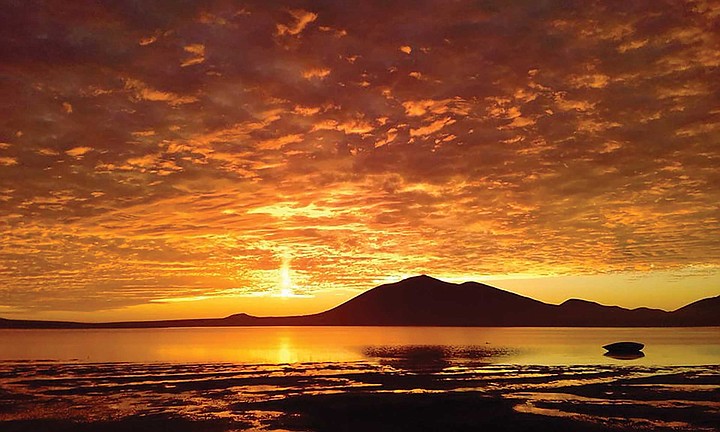
About that: my folks had always told me to spend no more than one-quarter of my take-home pay on rent or a mortgage. Once upon a time, this was the standard for the blue-collar middle-class: a single provider could rent an average house on twenty-five percent of their pay. And from post-World War Two into the early 1980s, this was the case. For a few years during the later part of that period, I worked as a journeyman carpenter, and I could easily rent a house. Even when I was working for minimum wage in a kitchen, I could afford a small apartment. That’s part of why I headed south: I knew that in Mexico, outside of the gentrified touristy places, the local economies were more like what we once enjoyed in the United States.
As in the U.S., rents and pay vary by location in Mexico. In the San Quintin area, an average skilled construction worker earns about 500 pesos per day. The average house rents for around 2500 pesos. My four-bedroom house on the shaded fenced lot was 2250 pesos, or about $140 dollars, given the exchange rate at the time. My water bill was 50 pesos, electric averaged 200 pesos, internet was 400 pesos, and I used about 150 pesos’ worth of propane each month. Cell phone with unlimited service in Mexico, the U.S., and Canada ran 200 pesos per month. Farm workers make about 350 pesos per day, and apartments in one of the many small communities throughout the San Quintin farming region start at around 800 pesos per month. In Mexico, the working classes are much better off when it comes to housing and bills than their U.S. counterparts.
Baja bumps and blessings
Given the cost of living and my 12-hour or so weekly commitment online for work, I enjoyed a lot of free time for fishing. I would haul my kayak out to the Boca launch or run to the beach most days of the week, depending on the weather. After a few months, my employer began direct deposit, so I no longer needed to run north once every other week. To remain legally there, I only had to go north to re-up my Forma Migration Multiple, or FMM, once every six months, at a cost of around $30. I spent much of my time exploring the bay’s fisheries by kayak or on foot, and eventually bought a little boat on a trailer for cheap and traded some unneeded fishing gear for a 15-horsepower motor. That way, I could take my dog Flash Gordon fishing when on the water instead of locking him in the yard while I was gone.
I stayed in that house in San Simon for about 18 months, until I ran into my first issue with the landlord. When I moved in, I noted that the water pump pressure tank — improperly installed and unprotected from the weather — was rusting and would need replacement soon. He agreed at the time, but when the tank finally burst, he said replacement was my responsibility. On principle, I decided not to give him the $200 for the new parts and quickly found another place within my budget; a modern two-bedroom, two-bath house on a large, fenced lot fronting the bay on the east side about a mile south of the Old Mill. It was owned by an American and the rent was $200 per month. My utility, internet, and cell phone bills ran about the same as the San Simon place, so the total of around $260 per month was still within my budget. And I had steps to the bay just twenty feet from the back gate.
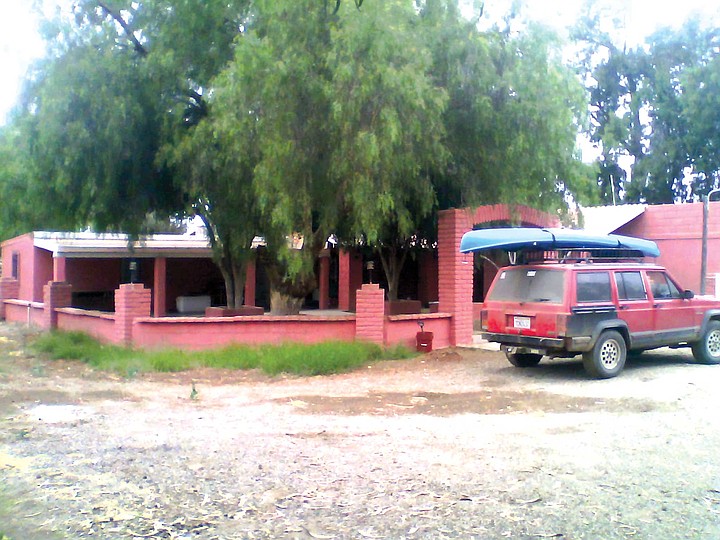
While in San Simon, most of my fishing was from the Boca or the beach; I had not spent much time in the inner and upper bay. Given constant action, it was hard to wrench myself away to try other spots. When I moved into the bayside house, I tossed a piece of shrimp out just to see what might be feeding in the littoral zone during the high tides. Walking the flats when the tide was out, I could see signs of fish “blowing” out the ghost shrimp, and even the impressions of smaller halibut and large rays in the clay. Within a couple minutes, I was on a 20” corbina and knew I had found a fisherman’s paradise of a house. Soon, I was walking a few strides from my back door with coffee in hand and enjoying some of the best corbina fishing I have ever experienced sitting there on the steps while taking in the fantastic view of the volcanoes and the upper bay.
The bay is oh-kay
On a six-foot high tide, the water came up to the top of the second step, while on a minus tide, it was about a hundred yards walk from the steps to the water’s edge. Much of Bahia San Quintin is flat and shallow in the littoral zone between the tides, the bay growing and shrinking up to 20% or more in area daily. On larger tide swings, the vast volume of acre-feet of water rushes through the narrow bay mouth, which is why the main channel is cut so deep. Like arteries, channels feed from the main channel into each false bay, creating an image of a lung expanding and contracting, filling and depleting the littoral zones daily. Rays, bullseye pufferfish, bonefish, and corbina flood into the clay above the eelgrass line on each high tide to feed on the ghost shrimp beds. Spotted bay bass, young grouper, and halibut lurk in the channels and along the rocky edges in the deeper water beyond the lowest tideline.
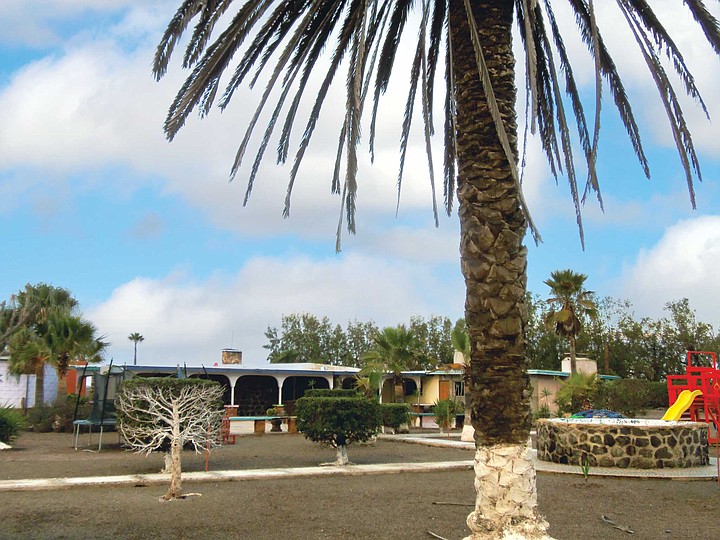
Though I occasionally hauled the little boat to the point launch at the Boca or the launch at the Old Mill, I began launching my kayak right from my back steps and exploring the mid and upper bay. In doing so, I quickly learned to lock the then-two-year-old Flash Gordon in the house while gone. He would get anxious, escape the yard and swim out after me. Once, he swam over a half-mile to a sailboat anchored in the channel. After picking him up at the sailboat and scooping him out of the water onto the narrow kayak several times, I realized there was no keeping him in a fenced yard if he really wanted out, so indoors he went on the days I kayak fished.
Once the dog situation was addressed, I found that the upper bay channels and rocky edges held plenty of gamefish action.
The quote about San Quintin Bay from The Baja Catch — the highly touted “fishing bible” covering Baja’s inshore waters of the Pacific Ocean and Sea of Cortez — reads, “Fishing inside the bay is a bust, due to weeds, shoals, and lack of fish.” This, in spite of the authors’ exhaustive research and decades of Baja experience, is the opposite of the truth. I found the bay choked with fish and a nursery for larger species. My average spotted bay bass has been around three pounds, though I am sure there is a world record in there at over 4 pounds 15 ounces, which is the standing mark to beat. Though much of the shoreline can be prohibitive to fishing, if you use a float tube, small boat, or kayak, the numerous ghost shrimp beds, the miles of channels and edges, and the plethora of bait makes Bahia San Quintin an excellent fishery for anyone who takes the time to explore it.
As the farming community has grown over recent decades, so has the available sportfishing fleet. Along the road leading into the Old Mill there are several sportfishing operations where one can hire anything from a small panga to a fully fitted Parker. All the operators are excellent guides and know the fisheries inside and outside the bay well.
For surf anglers, the quality of barred surf perch and corbina fishing along the beaches outside the bay to the north and south is first rate, in my opinion. Shore-pounding the accessible areas of the bay with lures or bait on high tide can produce some fat spotted bay bass, halibut, small broomtail and gulf grouper, corbina, and bonefish. Inshore and offshore fishing for yellowtail can be “off the hook” seasonally, and the calico bass fishing around Isla San Martin is excellent.
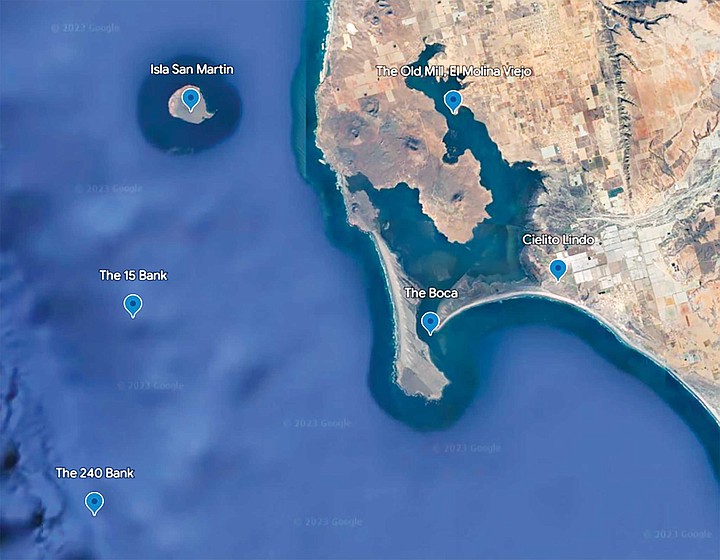
Neil Kelly and Gene Kira, the authors of The Baja Catch, are rightfully respected, and I have found their accounts of fisheries on either side of the peninsula to be accurate. But I am happy to report that they got this one wrong.
A sort of homecoming
Flash and I lived at the house on the bay for a couple years, and enjoyed every bit of it. As my work and pay waned, I continued to search out affordable spots in Mexico, and after spending some time in Baja Sur off the Vizcaino coast, I have returned to San Quintin, my old haunt and my dog’s birthplace, and to Cielito Lindo. The old cat Molly passed at 18 years old while here last fall, and is buried nearby in a pleasant spot with a view of the volcanoes and the beach.
Even when I was not living here, the old Hollywood hangout was a required stop when passing through. It is my home port in a lot of ways, and many of the folks here are like family. As with anywhere, the San Quintin area does have some drawbacks: there is a persistent onshore wind, and the cold-water zone weather can be gray and chilly. And on the days when the wind dies during late summer and early fall, mosquitoes and gnats can be horrific. But sitting out a few breezy days per week or donning a hoodie and mosquito repellents are minor inconveniences, considering the great fishing, broad uncrowded beaches, good people, and amazing intertidal biosphere that is just a half-day’s drive from Downtown San Diego.


Moving to the San Quintin area in 2015 was more accident than planned, but it wasn’t entirely random. Whenever I’ve pulled up stakes and moved on, for whatever reason — work, family, relationship, or a dart thrown at a map — I have been quick to find the fishing in my new environs. This time, I was basing my decision on distance: I needed someplace from which I could make the round trip to San Diego in a day. Say, four to five hours drive-time. That way, if I timed my border crossings well to avoid sitting in traffic, I could make it from home to Downtown San Diego — there to pick up the bi-weekly check that paid for my life in Mexico — and still sleep in my own bed that night. I aimed for someplace between Ensenada and El Rosario, drawn, as ever, by the water and what was swimming around under its surface.

The easiest way to search for a place to live is to go online. But when is the easiest way ever really the best? I knew I would find better deals speaking the with locals. My normal M.O. when I’m planning on an extended stay in Baja to find an area, make a deal for a week or maybe a month at a cheap motel, and then start looking through local channels; people you meet while out and about, notes posted outside of tiendas, that sort of thing. So I started driving south. A two-bedroom house for $600 in La Misión was tempting, but overbudget. A trailer by the Rosarito Beach Pier was within budget, but I wanted to be south of Ensenada and in a more rural setting. There were possibilities in Camalu, Colinet, and in the San Quintin Valley, but I found that the further south I drove, the further south I wanted to be. I decided to push my one-day round-trip requirement to its limit.
I was thinking El Rosario, but thanks to all my stops along the way, the sun was setting, and I typically avoid night driving in Baja. Besides, the cat started yowling — Mollison McReedy, the stray I found when she was more mouse-sized than cat-sized, and starving in the rocks on the Mission Beach jetty. She’d lived in Mexico before, back in 2005-2008 when she was a younger, better murderer of scorpions and mice, and I was plunked down outside of La Paz. Tired from the road, I pulled off the highway at the Los Piños Pemex station and headed four miles toward the beach and the Cielito Lindo Hotel.
A little Hollywood in the history
There’s a story that Mark Armistead, after he invented the instant replay for television, took his million-dollar check from NBC and tried to cash it at the bar of his favorite restaurant, Newport Beach’s El Pescador Restaurant and Bar. He was kidding, but the money was serious, serious enough that in the late ‘60s, Armistead was able to buy Rancho El Manana, 400 acres of sandy flat scrub land between the sloughs of Bahia San Quintin and the dunes fronting Playa Santa Maria, about 180 miles south of San Diego. Maybe his buddy the director John Ford had spotted it while spying on Japanese vessels in coastal Mexican waters in the late 1930s before the outbreak of World War Two, or during one of their many fishing trips down the coast after the war. However he found it, it seemed like the perfect spot to recreate El Pescador and invite the same Hollywood heavies with whom he’d dined there. Armistead named his recreation Cielito Lindo, Spanish for “pretty little sky.” Or it could be “nice little heaven.” The point is that the view is nice.
Large hotel rooms were added in three single-story fourplex units, floored with onyx tiles sourced from the once-famous and largest onyx-producing quarry in the world, El Mármol, located inland and about a third of the way down the Baja Peninsula. Armistead, a naval pilot and photographer during the war, installed an airstrip, and soon he and Ford — along with other Hollywood notables, including John Wayne, Henry Fonda, and Jimmy Stewart — started flying down to escape the paparazzi and fans in Los Angeles.

Mexico abounds with tales of famous visitors, from writers who loved fishing, like John Steinbeck and Ernest Hemingway, to actors who loved loving, like Elizabeth Taylor and Richard Burton. The Lover’s Bridge in Puerto Vallarta is so named because of their affair during the filming of Night of the Iguana, a tryst so public that it was condemned as “erotic vagrancy” by the Vatican. As it happened, Liz and Richard’s affair is pointed to as the beginning of the public “craze” of fandom — which is why Armistead and company desired a private getaway out of the public eye.
It seems they achieved their dream: there were no pictures or signed headshots behind the bar. What stories might have been told about the Hollywood crowd while at Cielito Lindo, if there were any, circulated far away from the eyes and ears of historians, the press, or any other public record. What is known is that when the highway was paved and RVs full of tourists began venturing south beyond Ensenada, Mark Armistead put the place up for sale, and it was bought by Juanita Fitzpatric in 1975.
Though she sold the restaurant, bar, and hotel to a ranching family from Mexicali prior to my moving here, Fitzpatric still holds title to the leased properties on the remaining acreage, where some 37 residents have built off-grid homes. A lot runs $100 down and $65 per month. Most of the homes are on solar and have generators as backup — as do the bar, restaurant, and hotel. Water is delivered to storage tanks, or pilas, by truck at a reasonable price. Every day, rain or shine, at 4 pm, happy hour draws the residents to the outdoor seating area, where locals, dogs, and guests all mingle.
El Pescador
Affordable rates a half-day from San Diego; it was time to assess my other nonnegotiable: a decent kayak launch. I found one at the bay mouth, or Boca, a few miles up the spit. The fact that the place was walking distance to the beach was just a bonus. Cielito Lindo soon became my home base, even though I hadn’t yet realized the potential of the area. Having previously lived in La Paz and Mulege, and having spent my vacations somewhere between Gonzaga Bay and the East Cape, I associated Baja with Tuscon-type warmth and near-tropical Sea of Cortez water. Exploring and fishing the Pacific side of the peninsula was going to be a new adventure in an almost foreboding place, what with its not-so-ancient volcanoes, shallow bay, and shallow sloping beaches. It almost seemed more like Central California: gray and cool, with a long paddle to the fishing grounds. The fishery held good rockfish, yellowtail, and white seabass — if you had the boat to do 25-40-mile round trips. But it seemed less than ideal for kayak-angling. I had gotten a little spoiled on the east side, where I could paddle out and chase dorado and tuna within a mile of the beach — and catch yellows just by chucking iron from shore.

My first launches at the bay mouth resulted in lots of sand bass and a couple of small halibut, and my first sand crab-chucking beach trips produced some barred surf perch and corbina. But then I started to learn more about the history of the place and the fishery, much of it from Captain Juan Cook, who runs a sportfishing operation out of The Old Mill, a hotel on the upper bay on the site of a mill built to process grain grown by British wheat farmers in the early 1900s. I began taking trips on pangas — the small skiffs that are the working boats of Mexico.
Catches on the 15 and 240 banks, as well around Isla San Martin (see photo), were the expected seasonal targets: rockfish, lingcod, and yellowtail from the high spots, seasonal tuna and dorado offshore, and white seabass, halibut, and really good calico bass on and near the kelp around the island. Often, large sheephead and whitefish were in the mix, too.
The panga fishing was good, but I still made time to explore the bay from the low perch of my kayak, and I made sure to talk to local fishermen — commercial and recreational — about what it held. What I found was a huge nursery for all kinds of gamefish, choked with bait — from finfish and to unending ghost shrimp beds in massive natural littoral zones, or “false bays.” A local handyman who fished for extra money told me of the large green and white shrimp —the latter known as cameron de leche or “milk shrimp,” due to their naturally white tail meat — that inhabited the bay. He caught them by casting his net in the sloughs after a high tide had dropped and left pools he could access. He brought me a couple kilos of them; the would be sold as extra-large at U.S. markets.
Over the first few months of kayak fishing within the bay — from the Boca up to the Old Mill – my catches included bonefish, young black seabass, juvenile gulf and broomtail grouper, halibut, sole, sand bass, spotted bay bass, numerous rays, a large spawning white seabass, juvenile white seabass, and California corbina. I even found I did not have to paddle very far for yellowtail: I caught one in the shallows near the launch at the Boca, and several within the mile-and-a half-paddle from there to the point.
Over the years since first fishing in the San Quintin area in 2015, I have caught my personal best California corbina (5.7 pounds) and barred surf perch (3.17 pounds) from the beach; and from the kayak in the Boca, white seabass (55 pounds), and kept black seabass (75 pounds). Fun fact: a kayak can act as a bobber might for a perch; a large fish that would take all your line from a boat will often just wear itself out towing a kayak. The angler can button down the drag and not be broken off. Once I’ve gaffed the fish, I normally use a bat to knock it out. Then I can remove the hook and store it in my forward hatch, or leash and tow it if it’s too large.

Bed and board
But all that came later. After first arriving, tired and accompanied by an aging, grouchy cat, I made a deal with the owner of Cielito for a monthly rate for one of their spacious rooms. I was in no real hurry to find a house, and I still wanted to check El Rosario. But I soon became very comfortable there, given the large room and everything provided, along with a restaurant and bar just steps away. I paid about $300 US per month plus my restaurant tab, which was adjusted to accommodate the fish I provided. The owners, Jose Raymundo Aguirre (known as Bebo) and family, have a ranch in Mexicali, and maintain Cielito as a summer getaway. They do not fish often, but they love halibut, corbina, white seabass, and the like.
After three months at Cielito, I had adopted a puppy born to one of Bebo’s dogs and named him Flash Gordon, caught my personal best halibut by kayak at 44 pounds, and made up my mind to stay in the area. I started looking for a place with a yard. Flash Gordon was growing fast, and I was getting tired of the cat being 100% indoors as well. I preferred her usual set-up as an in-out cat that didn’t need a litter box, one who would happily show off her good work by depositing mortally wounded scorpions or mice by the front door. Though she was pushing a decade by then, she still had her murderous instincts, and I did not want to deny her the pleasure.
I put out some feelers and found a rustic house on a well-manicured, treed, and fenced half-hectare a couple miles from Cielito Lindo in San Simon, a small neighborhood off the old highway. (The highway was moved about a mile east at San Simon for a stretch of about five miles, after flooding in the ‘90s convinced the government that a bridge made a practical alternative to constant road repairs.) Several dozen houses (mostly occupied by farm workers) and a couple of stores remain along the old stretch, just out of the flood zone.
This new place, with its fig, guayaba, and shade trees, was only a few miles from the water. Including rent, electric, gas, water, and internet service, my bills ran about $200 per month — or about one-sixth of my average monthly pay.

About that: my folks had always told me to spend no more than one-quarter of my take-home pay on rent or a mortgage. Once upon a time, this was the standard for the blue-collar middle-class: a single provider could rent an average house on twenty-five percent of their pay. And from post-World War Two into the early 1980s, this was the case. For a few years during the later part of that period, I worked as a journeyman carpenter, and I could easily rent a house. Even when I was working for minimum wage in a kitchen, I could afford a small apartment. That’s part of why I headed south: I knew that in Mexico, outside of the gentrified touristy places, the local economies were more like what we once enjoyed in the United States.
As in the U.S., rents and pay vary by location in Mexico. In the San Quintin area, an average skilled construction worker earns about 500 pesos per day. The average house rents for around 2500 pesos. My four-bedroom house on the shaded fenced lot was 2250 pesos, or about $140 dollars, given the exchange rate at the time. My water bill was 50 pesos, electric averaged 200 pesos, internet was 400 pesos, and I used about 150 pesos’ worth of propane each month. Cell phone with unlimited service in Mexico, the U.S., and Canada ran 200 pesos per month. Farm workers make about 350 pesos per day, and apartments in one of the many small communities throughout the San Quintin farming region start at around 800 pesos per month. In Mexico, the working classes are much better off when it comes to housing and bills than their U.S. counterparts.
Baja bumps and blessings
Given the cost of living and my 12-hour or so weekly commitment online for work, I enjoyed a lot of free time for fishing. I would haul my kayak out to the Boca launch or run to the beach most days of the week, depending on the weather. After a few months, my employer began direct deposit, so I no longer needed to run north once every other week. To remain legally there, I only had to go north to re-up my Forma Migration Multiple, or FMM, once every six months, at a cost of around $30. I spent much of my time exploring the bay’s fisheries by kayak or on foot, and eventually bought a little boat on a trailer for cheap and traded some unneeded fishing gear for a 15-horsepower motor. That way, I could take my dog Flash Gordon fishing when on the water instead of locking him in the yard while I was gone.
I stayed in that house in San Simon for about 18 months, until I ran into my first issue with the landlord. When I moved in, I noted that the water pump pressure tank — improperly installed and unprotected from the weather — was rusting and would need replacement soon. He agreed at the time, but when the tank finally burst, he said replacement was my responsibility. On principle, I decided not to give him the $200 for the new parts and quickly found another place within my budget; a modern two-bedroom, two-bath house on a large, fenced lot fronting the bay on the east side about a mile south of the Old Mill. It was owned by an American and the rent was $200 per month. My utility, internet, and cell phone bills ran about the same as the San Simon place, so the total of around $260 per month was still within my budget. And I had steps to the bay just twenty feet from the back gate.

While in San Simon, most of my fishing was from the Boca or the beach; I had not spent much time in the inner and upper bay. Given constant action, it was hard to wrench myself away to try other spots. When I moved into the bayside house, I tossed a piece of shrimp out just to see what might be feeding in the littoral zone during the high tides. Walking the flats when the tide was out, I could see signs of fish “blowing” out the ghost shrimp, and even the impressions of smaller halibut and large rays in the clay. Within a couple minutes, I was on a 20” corbina and knew I had found a fisherman’s paradise of a house. Soon, I was walking a few strides from my back door with coffee in hand and enjoying some of the best corbina fishing I have ever experienced sitting there on the steps while taking in the fantastic view of the volcanoes and the upper bay.
The bay is oh-kay
On a six-foot high tide, the water came up to the top of the second step, while on a minus tide, it was about a hundred yards walk from the steps to the water’s edge. Much of Bahia San Quintin is flat and shallow in the littoral zone between the tides, the bay growing and shrinking up to 20% or more in area daily. On larger tide swings, the vast volume of acre-feet of water rushes through the narrow bay mouth, which is why the main channel is cut so deep. Like arteries, channels feed from the main channel into each false bay, creating an image of a lung expanding and contracting, filling and depleting the littoral zones daily. Rays, bullseye pufferfish, bonefish, and corbina flood into the clay above the eelgrass line on each high tide to feed on the ghost shrimp beds. Spotted bay bass, young grouper, and halibut lurk in the channels and along the rocky edges in the deeper water beyond the lowest tideline.

Though I occasionally hauled the little boat to the point launch at the Boca or the launch at the Old Mill, I began launching my kayak right from my back steps and exploring the mid and upper bay. In doing so, I quickly learned to lock the then-two-year-old Flash Gordon in the house while gone. He would get anxious, escape the yard and swim out after me. Once, he swam over a half-mile to a sailboat anchored in the channel. After picking him up at the sailboat and scooping him out of the water onto the narrow kayak several times, I realized there was no keeping him in a fenced yard if he really wanted out, so indoors he went on the days I kayak fished.
Once the dog situation was addressed, I found that the upper bay channels and rocky edges held plenty of gamefish action.
The quote about San Quintin Bay from The Baja Catch — the highly touted “fishing bible” covering Baja’s inshore waters of the Pacific Ocean and Sea of Cortez — reads, “Fishing inside the bay is a bust, due to weeds, shoals, and lack of fish.” This, in spite of the authors’ exhaustive research and decades of Baja experience, is the opposite of the truth. I found the bay choked with fish and a nursery for larger species. My average spotted bay bass has been around three pounds, though I am sure there is a world record in there at over 4 pounds 15 ounces, which is the standing mark to beat. Though much of the shoreline can be prohibitive to fishing, if you use a float tube, small boat, or kayak, the numerous ghost shrimp beds, the miles of channels and edges, and the plethora of bait makes Bahia San Quintin an excellent fishery for anyone who takes the time to explore it.
As the farming community has grown over recent decades, so has the available sportfishing fleet. Along the road leading into the Old Mill there are several sportfishing operations where one can hire anything from a small panga to a fully fitted Parker. All the operators are excellent guides and know the fisheries inside and outside the bay well.
For surf anglers, the quality of barred surf perch and corbina fishing along the beaches outside the bay to the north and south is first rate, in my opinion. Shore-pounding the accessible areas of the bay with lures or bait on high tide can produce some fat spotted bay bass, halibut, small broomtail and gulf grouper, corbina, and bonefish. Inshore and offshore fishing for yellowtail can be “off the hook” seasonally, and the calico bass fishing around Isla San Martin is excellent.

Neil Kelly and Gene Kira, the authors of The Baja Catch, are rightfully respected, and I have found their accounts of fisheries on either side of the peninsula to be accurate. But I am happy to report that they got this one wrong.
A sort of homecoming
Flash and I lived at the house on the bay for a couple years, and enjoyed every bit of it. As my work and pay waned, I continued to search out affordable spots in Mexico, and after spending some time in Baja Sur off the Vizcaino coast, I have returned to San Quintin, my old haunt and my dog’s birthplace, and to Cielito Lindo. The old cat Molly passed at 18 years old while here last fall, and is buried nearby in a pleasant spot with a view of the volcanoes and the beach.
Even when I was not living here, the old Hollywood hangout was a required stop when passing through. It is my home port in a lot of ways, and many of the folks here are like family. As with anywhere, the San Quintin area does have some drawbacks: there is a persistent onshore wind, and the cold-water zone weather can be gray and chilly. And on the days when the wind dies during late summer and early fall, mosquitoes and gnats can be horrific. But sitting out a few breezy days per week or donning a hoodie and mosquito repellents are minor inconveniences, considering the great fishing, broad uncrowded beaches, good people, and amazing intertidal biosphere that is just a half-day’s drive from Downtown San Diego.
Comments